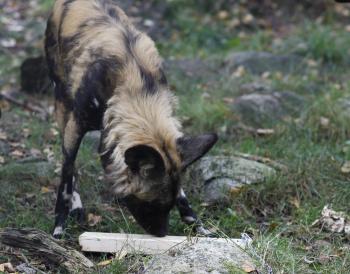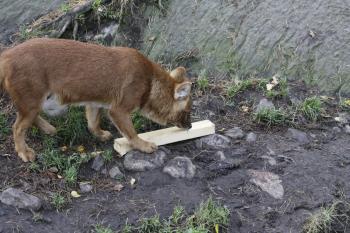Material & Methods

At the start of each experimental day, five wooden logs were odorized with one out of four odor stimuli (real horse blood, blood odor component, fruity odor or odorless solvent).
The wooden logs were thrown randomly into the enclosure of the dholes and the African wild dogs allowing the animals to play or otherwise interact with the logs and transport them across the enclosure.
The behavioral responses, the frequency of occurrence as well as the duration of all log-directed behaviors were recorded and compared between odors and species.

The four odor stimuli used in the present study were:
- Horse blood from domestic horse (Equus caballus) provided by Kolmården Wildlife Park.
- Blood component (trans-4,5-epoxy-(E)-2-decenal). This colorless odorant has been identified as a volatile component in mammalian blood and evokes a typical “metallic, blood-like” odor quality in humans. It has also been found to be a potent odorant of many foodstuffs, such as the "warmed-over" flavor of cooked beef and chicken.
- Fruity odor (Isopentyl acetate). This colorless odorant has been identified as a volatile component in a variety of fruits such as banana and apple. It has been described to evoke the odor quality of an over-ripe banana or a sweet “apple-like” odor in humans.
- Odorless solvent (diethyl phthalate). This colorless organic solvent is often used in fragrances and cosmetic ingredients. It is near odorless and was used both as a control stimulus and as solvent for the odorants trans-4,5-epoxy-(E)-2-decenal and isopentyl acetate in the present study.
Responsible for this page:
Director of undergraduate studies Biology
Last updated:
06/09/14
